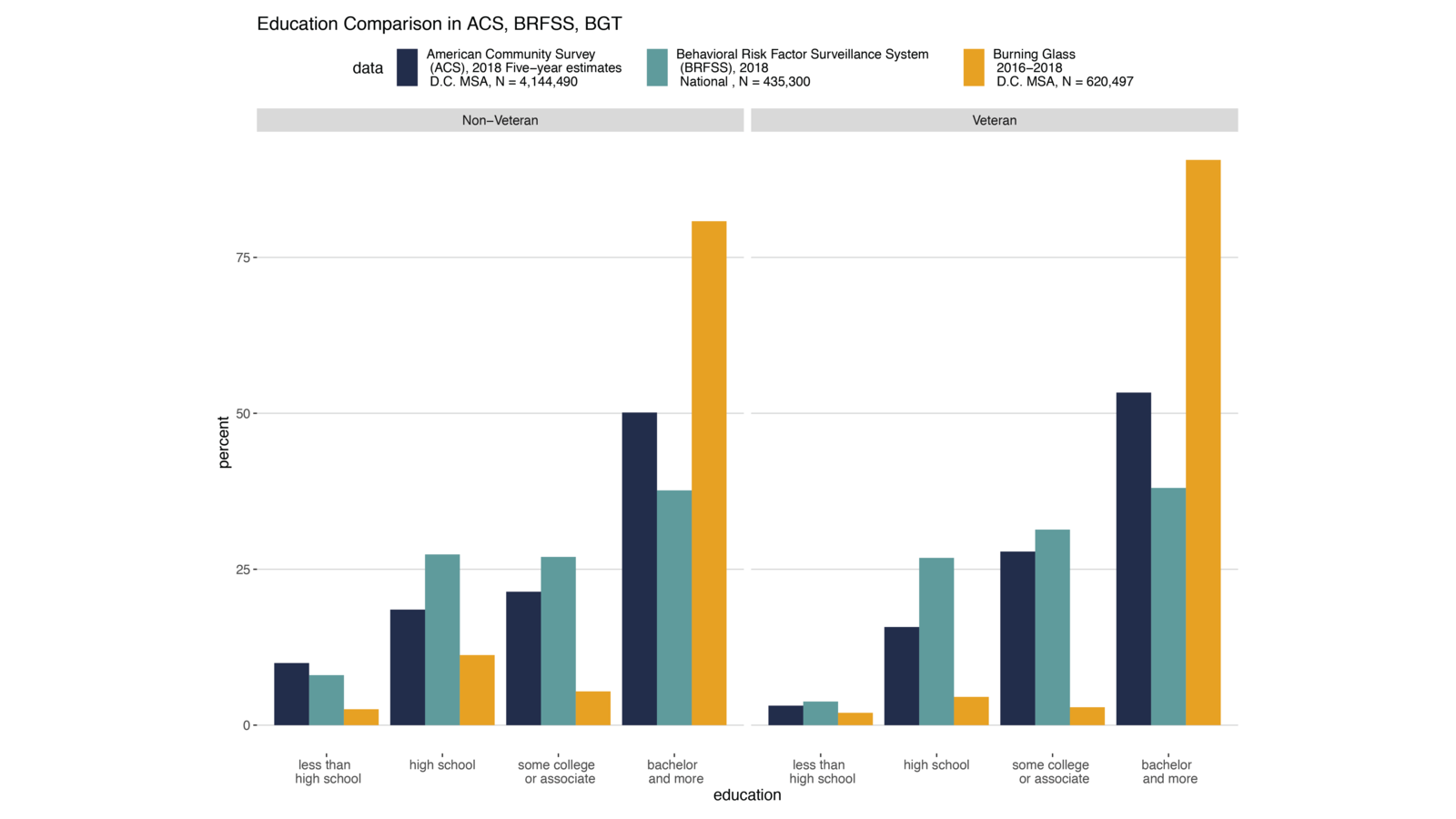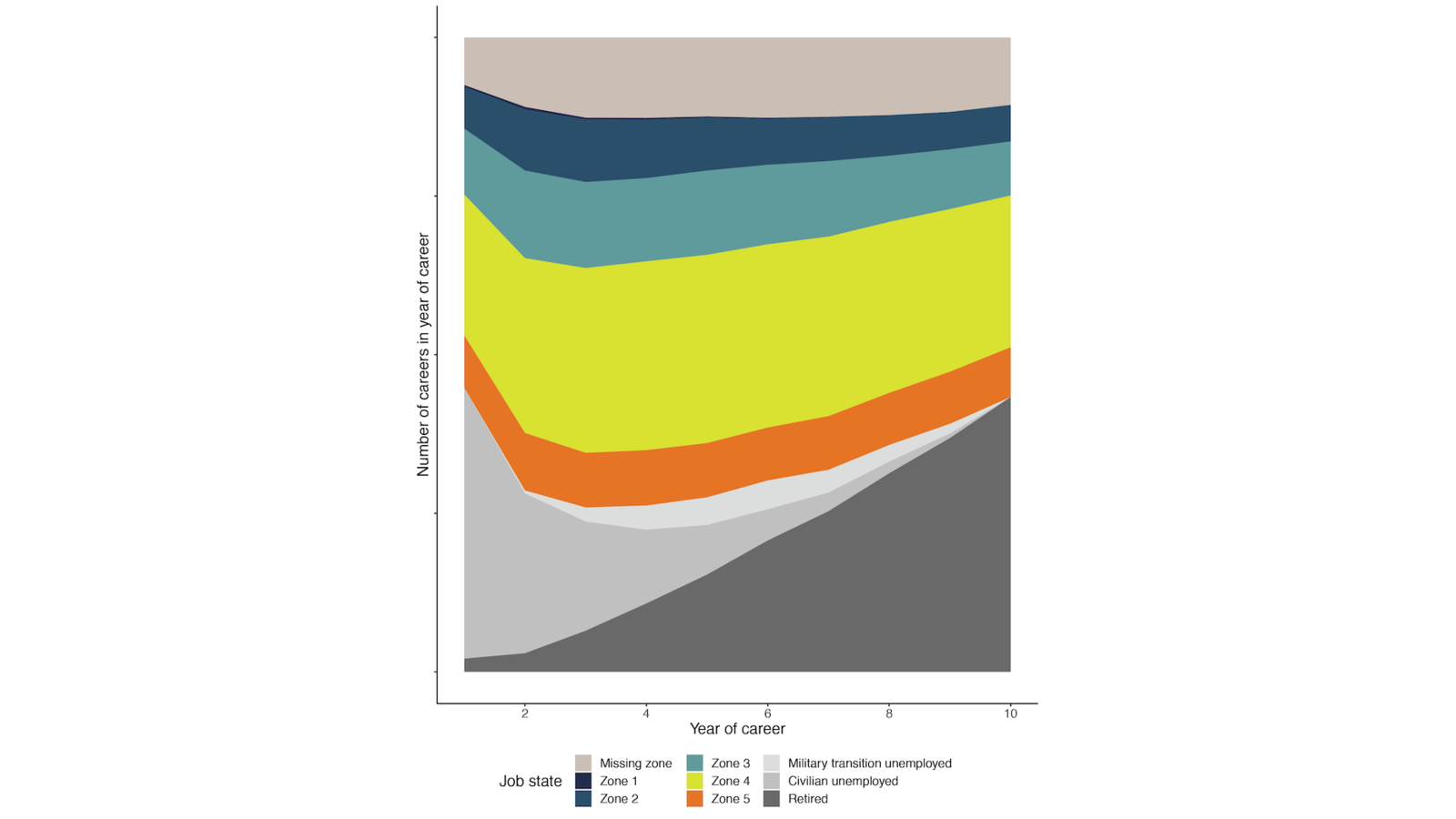We are developing statistical models to describe the career pathways of active-duty Soldiers and veterans. Our research integrates many sources of administrative and survey data that the Army collects about Soldiers, including training, positions held, deployments, command climate, demographics, and health. Using these data sources, we are building models that describe a Soldier’s career pathways to develop a longitudinal characterization of the way a Soldier acquires knowledge, skills, and abilities over time. These models can lead to new, more informed approaches to personnel planning and talent management.
Our initial analysis explores career pathways among U.S. Army veterans using Burning Glass Technologies (BGT) resume data. This includes data on resumes collected from publicly available sites between 2016 and 2018, and contains information about an individual’s education, certifications, skills, geographic location, and job history. The information on job history includes the position of each job on the resume, the dates the job was held, and the job zone, which measures the amount of preparation needed for a position and the Occupational Information Network (O*NET) Standard Occupation Classification (SOC) code of the job. O*NET-SOC codes also correspond with five O*NET job zones, which are grouped based on the amount of preparation needed for a position. We use moving between these job zones to represent career mobility.
We focus on Army veteran and non-veteran (everyone else) resumes in the Washington, D.C. Metropolitan Statistical Area. To assess whether BGT data are representative of Washington, D.C. Army veterans, we used several data sources to compare the education levels and industries of the Army veterans identified in the resumes. An example of this comparison is in Figure 1, where we compare education in the American Community Survey (ACS), Behavioral Risk Factor Surveillance System (BFRSS), and BGT data for Army veterans and non-veterans in the Washington, D.C. area. To identify veterans, we used the O*NET-SOC codes (described above) that categorized military positions. The BGT data tend to over-represent white-collar and educated Army veterans compared to the broader Washington, D.C. Army veteran population as compared to BFRSS and ACS. This is understandable given that non-white-collar workers are less likely to post their resumes online.
Figures



Figure 1. Comparison of education levels for Army veterans and nonveterans in Washington, D.C. Metropolitan Statistical Area across three sources of data - ACS, BFRSS, and BGT data.
Figure 2. An example of a Soldier’s career path after leaving the Army. The numbers represent career states over time - larger numbers correspond to positions that require more experience (i.e., higher job zones). Source: BGT data for Army veterans in Washington, D.C. Metropolitan Statistical Area.
Figure 3. Number of careers in each job zone within 10 years after a Soldier exits the military.
Sequence Analysis for Types of Career Patterns
Sequence analysis refers to a method of longitudinal analysis (tracking the same individuals over time). A sequence orders events and their associated states along a linear axis. In this case, we track states of an individual’s career across time. The states in our sequence are O*NET job zones and types of unemployment (periods where no job zone was included). Formatting career transitions in this way allows us to consider an individual’s entire career at once, rather than focusing on a particular point in time. Figure 2 shows an example of a career sequence in our data. Sequence analysis can be implemented with the R package TraMineR, which enables both the analysis and visualization of sequences.
We define career mobility as a change towards a higher job zone. In Figure 3, we show the distribution of the five job zones within the first 10 years after a Soldier leaves the military. We can see a small increase in the proportion of veterans in job zones 4 and 5, and a decrease in the proportion of job zones 1 and 2 over time, though the fact that these changes are small suggests veteran careers are not very mobile in the first 10 years after military exit. This figure also tracks three different states of unemployment: transitional unemployment (periods of unemployment when a veteran is transitioning from a military to a civilian career, possibly due to education), civilian unemployment (unemployment in the more traditional sense, after a civilian career has been established), and retirement or exit from the workforce. Figure 3 shows high proportions of unemployment for veterans in the first and tenth years after military exit. In the first year, almost half of veterans are in a state of military transitional unemployment. By the tenth year, almost half are retired or have exited the labor force.
Further analysis of both veterans and active-duty Soldiers is ongoing. You can read more about our analysis of Army veterans, including additional methods and results here.




